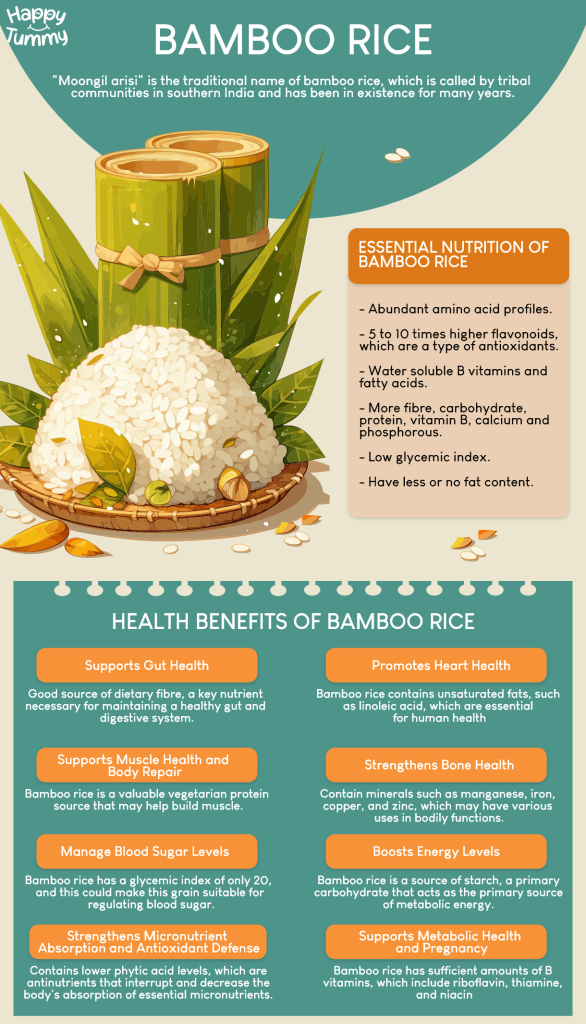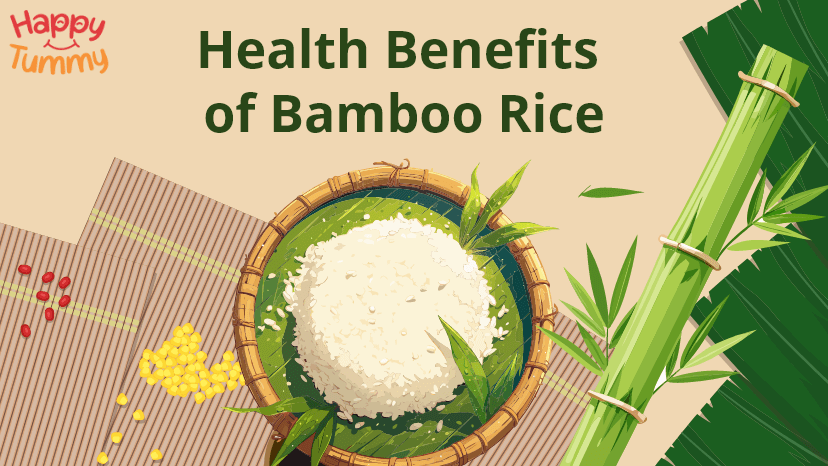Table of Contents
Bamboo rice is the seed of bamboo which is consumed after being well cooked. In comparison with the other alternatives, bamboo rice offers an impressive array of essential nutrients, such as [1] [2]:
- Abundant amino acid profiles.
- 5 to 10 times higher flavonoids, which are a type of antioxidants.
- Water soluble B vitamins and fatty acids.
- More fibre, carbohydrate, protein, vitamin B, calcium and phosphorous.
- Low glycemic index.
- Have less or no fat content.
Bamboo seeds or bamboo rice are believed to contain components that may benefit human health [3]:
- With a low glycemic index and rich nutrient profile, bamboo rice may help manage blood sugar and cholesterol levels, alleviate joint pain and swelling, and also benefit from conditions like rheumatoid arthritis.
- May help in removing toxins from the body.
- It might aid in managing menstruation and respiratory-related conditions.
- Bamboo rice is also used in some regions for digestive issues and urinary tract infections [4].
Thus, bamboo rice might be considered a potential functional food that may bring health benefits to people in a sustainable manner.
If you’re looking for a nutritious option or just hoping for a new product to add to your meal, consider bamboo rice. It is a tasty, versatile, and multipurpose food.
What is Bamboo Rice? [5]
“Moongil arisi” is the traditional name of bamboo rice, which is called by tribal communities in southern India and has been in existence for many years. Here’s a detailed breakdown that will help you understand its origin and usage:
- Bamboo belongs to the family Graminea, which also includes other cereals such as rice, wheat, and barley [6].
- Bamboo rice refers to the seeds of bamboo plants, primarily from the Bambusa arundinacea species native to India. Most of the bamboo seeds resemble grains of rice. However, bamboo seeds are found in different shapes, such as ellipse, oblong, and ovoid or broad ovoid [7].
- Bamboo plants flower once in their lifetime, approximately every 40 years.
- The flavour of bamboo rice is often compared to wheat or Japanese sushi rice.
Whichever food you eat, understanding your daily fibre intake is essential for supporting your health goals.
To ensure complete nutrition, Aashirvaad’s My Meal Plan offers a quick, interactive test that assesses the fibre levels in your current diet. With personalised insights, you will also receive a comprehensive meal plan guide to help meet your recommended fibre needs.
Health Benefits of Bamboo Rice

1. Supports Gut Health [8]
- Bamboo rice is a good source of dietary fibre, a key nutrient necessary for maintaining a healthy gut and digestive system.
- Thus, it may aid digestion and manage constipation by promoting a healthier gut microbiome.
- It may also help support weight management as it is high in fibre and low in energy and fat [9].
All such factors make bamboo rice an excellent choice for those focusing on digestive wellness. To better understand your gut health, take the quick two-minute Aashirvaad Digestive Quotient test. This test scores your digestive wellness out of 100 and may help you understand areas for improvement.
By understanding your digestive health better, you can make informed choices about your diet, including incorporating high-fibre foods that maintain optimal digestive health and support overall gut function.
2. Promotes Heart Health
- High fibre and healthy fats are beneficial for heart health.
- It contains unsaturated fats, such as linoleic acid, which are essential for human health because the human body does not synthesise them and needs to acquire them from a healthy, balanced diet [10].
- Hence, regular consumption of bamboo rice may help increase HDL and manage cholesterol levels and thus contribute to cardiovascular wellness [11].
3. Supports Muscle Health and Body Repair
- Bamboo rice is a valuable vegetarian
proteinsource that may help build muscle [12]. - It also provides all ten essential amino acids, including lysine, which is notably higher in bamboo rice than in many other grains. These amino acids are crucial for enhancing health, making bamboo rice an excellent plant-based protein source [13].
4. Manage Blood Sugar Levels
- It has a glycemic index of only 20, and this could make this grain suitable for regulating blood sugar [14] [15].
- It is also high in dietary fibre [16], which may slow down glucose absorption and fluctuations in sugar levels. Therefore, diabetic patients may consume bamboo rice. However, be sure to take advice from your healthcare provider or diabetologist before making any changes to your regular food habits.
For those who wish to maintain their fibre intake, Aashirvaad Atta with Multigrains offers a fibre-rich option that may support your overall health.
This multigrain atta, made from six grains, ensures that with just three rotis, you get 35% of your daily fibre intake, making it easier to achieve and maintain your health goals.
5. Boosts Energy Levels [17]
- It is a primary carbohydrate that acts as the primary source of metabolic energy.
- Such carbohydrate composition may indicate that bamboo rice may provide adequate energy to the body for general physical activities and other essential cellular functions.
- Hence, bamboo rice may have the potential to provide natural energy for the body throughout the day without the usual physiological drawbacks associated with most high-glycemic-index foods.
6. Strengthens Micronutrient Absorption and Antioxidant Defense [18]
- Bamboo rice contains lower phytic acid levels, which are antinutrients that interrupt and decrease the body’s absorption of essential micronutrients.
- For this reason, it may enhance the bioavailability, absorption, and utilisation of certain micronutrients such as zinc, iron, and calcium.
- It may also benefit bone health and regulate blood glucose, triglyceride, and plasma cholesterol levels.
- It is rich in flavonoids, potent antioxidants that may combat oxidative stress and help manage inflammation.
- These might further help support cellular health and, thus, could be a good choice for those who wish to increase their nutrient intake.
7. Strengthens Bone Health [19]
- Bamboo seeds contain minerals such as manganese, iron, copper, and zinc, which may have various uses in bodily functions.
- Bamboo rice’s mineral-rich profile, especially calcium and phosphorus content, might be helpful to those suffering from joint pains [20].
- In Kerala, southern India, some tribal groups use bamboo rice for joint, back and rheumatic pains due to its mineral content [21] [22].
8. Supports Metabolic Health and Pregnancy [23]
- It has sufficient amounts of B vitamins, which include riboflavin, thiamine, and niacin, which might be essential for energy metabolism and overall well-being.
- Vitamins are necessary for the body. For instance, thiamine supports energy metabolism, while riboflavin contributes to skin and eye health.
- Some studies also indicate that these B vitamins might be crucial during pregnancy. It may aid in the brain development and cognitive function of the foetus. Thus, such nutrient density makes bamboo rice an excellent addition to prenatal nutrition [24] [25].
However, nutritional needs can vary greatly from person to person, and it’s important to consult with a health expert before making dietary changes, especially for those with medical conditions, on medications, or who are pregnant.
Aashirvaad’s Nutritionist Consultation makes this process simpler for you by providing expert dietary advice tailored to your unique health needs.
This ensures that you include the right foods in your diet safely and effectively.
Bamboo Rice Recipes
Bamboo rice is a nutritious and flavourful ingredient. Its taste and dense and unique texture make it versatile for savoury and sweet dishes.
Here are some easy recipes for you to try, although you can make adjustments according to your taste and preferences.
1. Bamboo Rice Payasam (Kheer)
This traditional Indian dessert is a creamy, sweet rice pudding made with bamboo rice, milk, dried fruits, and jaggery. It’s prepared during occasions, festivals, or as a comforting treat.
2. Bamboo Rice Idli and Dosa
It is a popular variant of South Indian breakfast made from fermented bamboo rice batter.
3. Chicken and Pineapple Stir Fry with Bamboo Rice
It is a spicy stir fry that combines tender chicken with sweet pineapple and colourful vegetables (like peppers and peas) and is served over fragrant bamboo rice.
4. Bamboo Rice Khichdi
Bamboo Rice Khichdi is a wholesome one-pot meal that combines it with lentils (moong dal) and vegetables (like carrots and peas), making it both nutritious and comforting.
5. Bamboo Rice Pudding
It is another sweet dish that features the rich flavour of coconut milk paired with the nutty taste of bamboo rice. To prepare this dessert, soaked bamboo rice is cooked with coconut milk and jaggery.
6. Bamboo Rice Upma
Bamboo Rice Upma is a light, savoury dish that’s quick to prepare. This upma is packed with flavours from spices and vegetables, which you may eat as breakfast.
Final Thoughts
In summary, bamboo rice is a unique and highly nutritious functional food option. As we learned, it is packed with essential nutrients like fibre, protein, flavonoids, vitamins, and minerals that may provide numerous health benefits.
Bamboo rice’s low glycemic index, antioxidant properties, and amino acids might support different aspects of health, including muscle support, blood sugar management, and joint health.
From promoting gut health through its high fibre content to supporting heart health with healthy fats, bamboo rice is worth considering as part of your balanced diet.
Bamboo rice has a rich nutrition profile that might align with various health goals. It further enhances its appeal as a healthy choice for individuals seeking healthier eating options and an alternative source of dietary nutrients.
FAQs
Bamboo rice can be included as part of a balanced diet. However, for variety and balanced nutrition, it’s advisable to maintain variety and alternate it with other grains such as regular rice, quinoa, brown rice, or millet throughout the week for balanced nutrition.
Bamboo rice is the common name for the seeds of wild bamboo plants. These seeds are collected after the bamboo plants have flowered once in their lifetime, around every 40 years.
After dehusking, the seeds produce brown seeds that resemble rice grains. The resulting grains are enriched with nutrients from the plant’s natural environment and have a taste and texture similar to wheat or Japanese sushi rice.
Bamboo rice can be cooked and eaten in various ways. You may cook bamboo rice in the same way as regular rice. Many people enjoy it as khichdi, as a side dish with dal and curries for everyday meals, or as a base for stir-fried vegetables. It may also be used in traditional Indian recipes, like kheer, a sweet dessert, especially during festivals.
Bamboo rice has a low glycemic index of just 20, which means it may not cause immediate spikes in blood glucose levels after eating. Its high fibre content may also aid in stabilising blood sugar, improving insulin sensitivity, making it a safe and nutritious option for people managing diabetes.
















